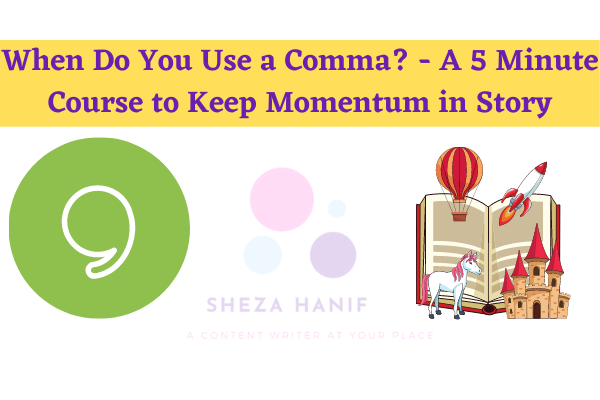I wouldn’t call myself a commander (yes, that word is really in the dictionary ). But I have to admit that sometimes I am a little too attached to the punctuation mark with which you chop a sentence into pieces. When do you actually use a comma in the right way?
In my texts, I often put commas in places where they don’t belong, or in sentences that read better without a comma.
For example, this sentence was in my last blog post:
In my exciting novel Savelsbos there are many metaphors that are too ordinary on closer inspection.
When do you use a comma?
The comma is unnecessary here. Like more people, I have an annoying habit of announcing almost every clause with the punctuation mark. Not necessary for anything, and you get the momentum out of your story.
You can read the above sentence just as easily, and maybe even easier, without a comma.
In my exciting novel Savelsbos there are many metaphors that are too ordinary on closer inspection.
How do you make sure that you don’t slow down your story with unnecessary commas? And when is the punctuation mark necessary? You can read that in the short guide below.
Manual: the guidelines
These 7 tips will help you not to place unnecessary commas, but also not to create confusion in your text.
1. Always put a comma between two-person forms
When two verbs or person forms collide in a sentence (ie are next to each other), you always place a comma.If you kiss me, I’ll slap you.
While we sing a song, we walk through the silence compartment.
Note: sometimes something looks like a verb, but it is not a verb and therefore nothing clashes.
Singing we walk through the silence compartment
We did not like singing
(‘Singing’ is an adverb here, and ‘singing’ is a noun. So there is no need for a comma in the sentences above).
2. Do not put it in front of a restrictive clause.
A restrictive clause is a clause that restricts the meaning of the main clause to a certain category or type. You can never omit a restrictive clause because then the meaning of the main clause changes.I don’t like to eat sandwiches that someone has already taken a bite of.
In this sense, ‘what someone has already taken a bite of’ is the limiting clause.
So: when do you put it? At least not for restrictive clauses. You take the momentum out of the sentence. The reader does not need to pause at all to understand the clause.
So not:
That’s a car that had a dent in our garage last night.
Well:
That’s the car that dented our garage last night.
* The comma in the aforementioned sentence from my previous blog post about metaphors stood for a restrictive clause. I could therefore have left it out.
3. Always put a comma in front of an expanding clause.
An expanding clause is a clause that provides additional information about a noun. This information is not necessarily necessary to understand the sentence. It is a kind of extra that you can omit without changing the meaning of the rest of the sentence.Cassette tapes, which hardly anyone uses today, can no longer be found in most stores.
The clause ‘that hardly anyone uses nowadays’ is expanding (you can omit it without affecting the meaning of the sentence about the cassettes).
For an expanding clause, always put a comma, so that the reader and any audience understand that it is a side path in your sentence, a block of extra information.
So not:
King William I, who came to power in 1028, was known as William the conqueror.
Well:
King William I, who came to power in 1028, was known as William the Conqueror
4. Put it between adjectives if they can switch places.
Only place a comma between adjectives if both say something about the noun separately, but nothing about each other. In that case, they can change places without any problems. Take the example:
The car was running on old, worn-out tires.
You can reverse these adjectives without changing the meaning, so you put a comma.
The car was running on worn-out old tires.
But in the next sentence, you are dealing with a special case.
The leader in the Tour de France had fallen into the mud. He was wearing a dirty yellow sweater.
Here you cannot swap ‘dirty’ and ‘yellow’ here without changing the meaning, so you don’t put a comma.
9 Ways to Find Freelance Writing Clients Who Will Actually Pay You
The Importance of Article Writing And How To Do It Effectively
“Never start a sentence with …” – 7 Writing Rules You Should Ignore
5. Do not put it before the conjunction ‘that’
If you use the word ‘that’ as a conjunction (so to glue two equivalent sentences together), it is better not to put a comma. That takes the momentum out of the sentence.
I think we’re going to win. Obviously, the dog is tired.
We are happy that it has become summer again.
In all these sentences a comma is superfluous.
6. A comma before ‘and’ is usually unnecessary.
There is a good chance that the teachers and masters taught you in school that you never had to put a comma before ‘and’. They had a point.As long as you connect two equivalent phrases with the conjunction ‘and’, a comma is indeed superfluous. If one of the two phrases is much longer and more complicated, you better put a comma. Then confusion is lurking.
The sun warms my skin and brightens the street.
The man gave me an apple and a banana.
A comma is not necessary for these sentences. They are easy to understand. But you get in trouble with a sentence like this:
The man gave me an apple and a parrot sitting on my shoulder took a bite of it.
Halfway through the sentence, the reader thinks: huh, does the man give you a parrot in addition to an apple? You can clarify the sentence with a comma.
The man handed me an apple, and a parrot sitting on my shoulder took a bite of it.
7. Always put it after a salutation
When writing an e-mail or letter, always put a comma after the name or title.Dear Mr De Hond,
Dear boy,
When a sentence ends with the person you are addressing, put a comma in front of it.
It was fun having a tomato fight with you, Grandma.
Want to read more?
As sources for this manual, I used Writing Guide (perhaps the best advice book on language and spelling) and the indispensable Quick Game Guide of Onze Taal, which contains a separate chapter on the question: when do you use a comma?
Don’t miss writing tips?
Writing an Introduction? This Step-by-Step Guide Will Help You
Is it Better to Delete Unnecessary Adjectives from Your Text?
What’s an Auxiliary Verb? Why You Should be Careful?
Bonus tip:
Note: sometimes you can unintentionally change the meaning of a sentence with an incorrectly placed comma.
Lotte sends a card to the children in her class, with which she experienced good times during the school trip in Greece.
Because of the comma after ‘class’ your reader understands the clause here as expanding. So Lotte treats everyone, and it is mentioned in passing that she had a great time with all the children in Greece. This is probably what you want to say.
But suppose you forget to put a comma in this sentence:
Lotte sends a card to the children in her class with which she experienced good times during the school trip in Greece.
Due to the absence of the comma, your reader should actually take the clause here to be restrictive. Lotte therefore only treats the children from the class with which she experienced good times in Greece.
In short: sometimes it is good to be a ‘comma killer’.
* No doubt I’ve put commas in this article where you think I shouldn’t have. Let me know in the comments.


You made some clear points there. I did a search on the issue and found most people will agree with your blog.